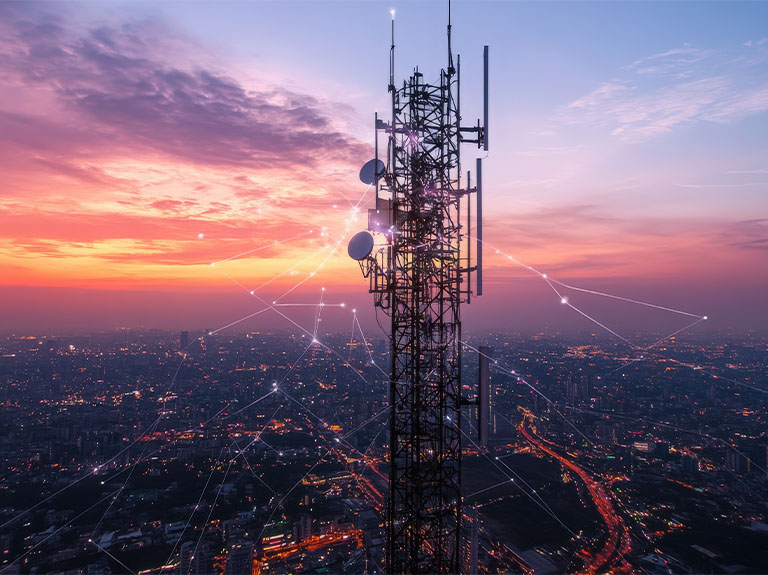Note: The following blog is based on comments made by Mo Katibeh at the “5G: The Future is Now” event at The Policy Forum at AT&T on Feb. 11 in Washington, D.C.
I have an important question for you: Chocolate Chip or Oatmeal Raisin cookies?
I'm sure you're wondering what in the heck cookies has to do with 5G. Well, let me tell you.
5G technology comes in different flavors and you can easily compare it to chocolate chip or oatmeal raisin.
For today, why don’t we go with a chocolate chip example?
At AT&T, the service we call 5G runs on sub-6 spectrum. That's the same spectrum bands that your smartphone today runs on. Those radio waves do a great job of carrying your calls and data sessions over wide geographic area and through the walls of buildings.
We’re rolling out that service now – with plans for nationwide coverage in the second quarter.
Think of 5G as the nice soft, delicious golden brown part of the cookie.
But there's also another flavor of 5G that runs on millimeter wave spectrum. We call it 5G+. It's ultra-fast. Like crazy fast, but it doesn't carry very far. And we are finding that we can bring 5G+ service to, and it works great, at specific businesses and high-traffic areas. Manufacturing plants. Hospitals. Stadiums.
Think of 5G+ as the chocolate chip. Sweet. Intense.
Here's why this is important as you compare AT&T to other companies who are deploying 5G. Some are all about the cookie. Some are all about the chips.
At AT&T, we want to give you both. That will mean a coverage experience for consumers and business employees with widespread 5G and an ultrafast 5G+ experience in specific locations. And as you'll see, that's good news for consumers but also for enterprise customers looking to transform their businesses.
And even better news - 2020 is the year that 5G goes mainstream.
Here's where we are today. AT&T currently has 5G service on sub-6 spectrum in 45 markets - available to 50 million people. We have our ultra-fast 5G+ millimeter wave service in parts of 35 cities.
Of course, coverage is not much good to consumers or businesses if it doesn’t have devices to attach to it!
That’s why we just announced that we would be adding another three 5G smartphones from Samsung’s S20 line. These devices will be available online and in AT&T stores starting March 6, 2020. And it only gets bigger from here - we expect to have 15 sub-6 5G devices on sale by the end of the year.
In my years with AT&T, I've lived through a few generations of wireless technology. The introduction of 5G technology is - without question - the smoothest transition I've ever experienced. The fact that networks are maturing at the same time that devices are becoming available does not happen by accident.
As a result, the United States is one of the world leaders in rolling out 5G technology. 2020 will be a pivotal point in the maturity of the 5G ecosystem as networks become nationwide, devices proliferate, and new applications come to market.
Since business customers are my focus, let me tell you how they are using 5G to create transformational experiences - and that brings us back to those chocolate chips. Those sweet, intense bits inside the cookie. Or in our analogy, those ultra-fast coverage zones that businesses and consumers are craving.
You know why businesses are craving this ultra-fast coverage? They see a way to transform processes… create efficiencies… do things they have never been able to do before for both their employees, and their customers.
After all, many of the efficiencies that the mobile internet and smartphones brought to businesses are now a decade old. Believe it or not, there was a time in the not-so-distant past where you did not have mobile broadband at your fingertips. Where you could not access your email, spreadsheets and presentations on the fly. Where it was not possible to use an app to access a rideshare service.
Those were dark days, my friends. Dark days indeed.
Now, mobile broadband is table stakes for any business – whether it’s your favorite neighborhood store or a Fortune 100 company.
Many of the use cases we think of as commonplace may have been unthinkable 20 years ago. Today, we stand on the dawn of a new decade with a host of new opportunities. I want to share a few of these with you.
In the last year, we’ve launched unique 5G experiences in manufacturing with Samsung Austin Semiconductor and in sports and entertainment at AT&T Stadium with the Dallas Cowboys, before the Big Game in Miami, and as part of NBA All Star Game! We’re helping create a “Smart Base of the Future” at Tyndall Air Force Base in Florida and a smart health building at the Lawrence J. Ellison Institute for Transformative Medicine of USC. We’re also working with The Washington Post on using 5G to explore the future of news.
And there’s more to come. A lot more.
Creating a technology revolution isn’t for the faint of heart or the impatient.
When I’ve spoken on 5G before, I’ve often compared it to the introduction of electricity in its potential to transform the business landscape.
I still believe that. Whether it's healthcare, manufacturing, retail, finance or public sector - or a news organization - 5G will help businesses accomplish things that they have never been able to before.
To accomplish that will take a variety of companies from many parts of the ecosystem working together. That's why AT&T is working with companies like Microsoft, IBM, HPE on 5G and associated cloud and edge computing solutions - bringing together infrastructure, device manufacturers and startups.
As the father of electricity, Thomas Edison once said: “There are no rules here - we're trying to accomplish something."


